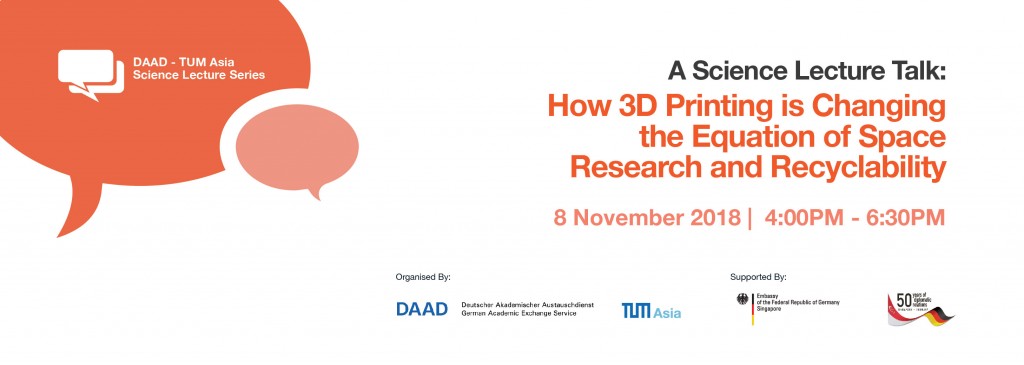
CubeSat is a type of miniaturized satellite for space research. It often uses commercial off-the-shelf components for their electronics and structure. 3D printing of such items in orbit would be cheaper and would change the equation of recyclability (thermoplastics), hence making space mission more self-sustaining. These materials should be stable, strong, and resistant to high temperature. Electrical functionality can be added by introducing nano-fillers to these materials. Such miniature satellite can be functionalised once the circuit boards, instruments and solar panels are incorporated.
Experienced academics and researchers will be sharing key emerging trends and developments in aerospace and additive engineering as well as raise awareness of the new opportunities and risks at play in areas of software-defined radio technology and hybrid electronic-mechanical structures.
Details of the Speaker Series’ Session
Date: 8 November 2018, Thursday
Time: 4:00pm – 6:30pm (Refreshments will be served)
Venue: SIT@SP Building, Level 5 (510 Dover Road, Singapore 139660)
Fee: Complimentary
4:00pm Registration
4:15pm Opening Address by the Singapore German Embassy & German Academic Exchange Service (DAAD)
4:30pm “CubeSat activities at TUM”
Dr. Martin Rott
Academic Director
Department of Astronautics
Technical University of Munich (TUM)
5:15pm “3D printing of hybrid electronic-mechanical structures”
Dr. Shweta Agarwala
Research Scientist
Singapore Center for 3D Printing
Nanyang Technological University (NTU)
6:00pm Tea & Networking Session
6:30pm End of Session
“CubeSat activities at TUM”
Dr. Martin Rott
Academic Director, Department of Astronautics
Technische Universität München (TUM)
The CubeSat programme Munich Orbital Verification Experiment (MOVE) was initiated in 2006 at the Institute of Astronautics (LRT) at Technical University of Munich (TUM). It focuses on technology demonstration and the hands-on education of students, complementing theoretical classwork knowledge in state-of-the-art aerospace engineering. The programme’s first CubeSat, First-MOVE, was launched in late 2013 and successfully operated in space. Being limited to single-unit size during launch, the satellite used deployable solar panels to overcome the power limitations of the envelope. The programme’s second CubeSat, MOVE-II is currently undergoing final tests and will be launched into a 575-km, sun-synchronous orbit by the end of 2018. The four deployable solar panels are made from carbon-fibre reinforced plastics and are equipped with 4-junction solar cells. A reusable shape memory mechanism holds down the panels during launch and releases them after deployment. The MOVE-II communication system consists of two independent systems: a continuously operating UHF/VHF system and an auxiliary S-Band system. Both systems are based on software-defined radio technology. Within the CubeSat programme, we also developed capabilities and set-up several facilities for satellite development and operations e.g. a class ISO 8 Clean Room, a Thermal Vacuum Chamber, a Ground Station (Ka-Band, UHF/VHF, S-Band) or a Mission Control Center. The talk will give an overview on the past and present involvement of the Institute in the CubeSat programme, with special focus and the latest information on MOVE II. The presentation will conclude with an outlook of our next missions.
“3D printing of hybrid electronic-mechanical structures”
Dr. Shweta Agarwala
Research Scientist, Singapore Center for 3D Printing
Nanyang Technological University (NTU)
The advent of additive manufacturing, commonly referred to as 3D printing, has enabled rapid production of labour-intensive parts with complex geometries and made possible to realise objects that cannot be processed through traditional manufacturing methods. The talk will focus on 3D printing techniques to create hybrid electro-mechanical structures with added functionalities for robotics, mechatronics, and articulated mechanism applications. Hybrid technology overcomes the inherent limitations of individual 3D processes and integrates electronics seamlessly. This facilitates the creation of bespoke end-use products with complex three-dimensional geometry and multi-layer embedded electronic systems. Design and development of multi-media manufacturing platform will be presented, detailing the technologies used and how they are integrated to enable printing of multiple materials using different additive manufacturing methods. The technologies used include aerosol jetting, fused deposition modelling, direct ink writing, photopolymer inkjet printing and other non-additive processes of photonic curing and robotic pick and place.
